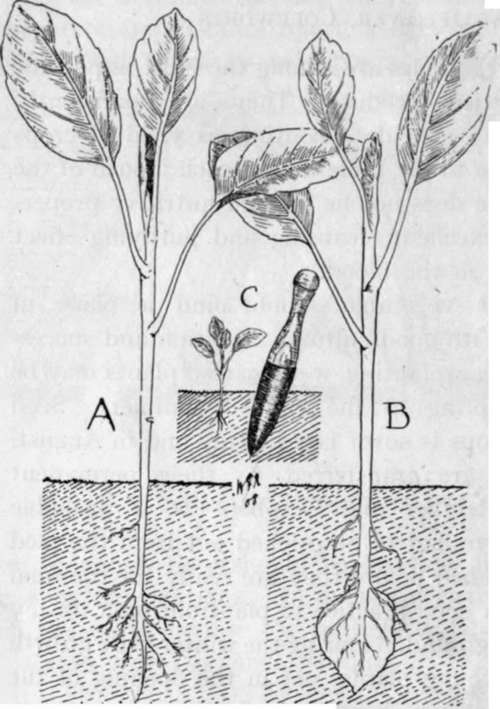Chapter VII. Green Vegetables
Description
This section is from the book "School Gardening", by W. Francis Rankine. Also available from Amazon: School Gardening.
Chapter VII. Green Vegetables
Cabbage, Savoy, Borecole, Brussels Sprouts, Cauliflower, Coleworts
Green vegetables are among the most important of garden produce. They are sufficiently hardy to provide a continuous yield of crops which are welcome to the table during each month of the year. Their value does not lie in high nutritive properties, but in the excellent cleansing and purifying effect which they have on the blood.
Cabbage
This vegetable should find a place in every garden. With good cultural attention and successive sowing and transplanting, well-hearted plants may be obtained from spring to the end of summer. Seed for the former crops is sown late in July and in August, and the plants are transferred to their permanent positions in September and October. It is probable that they will have had to be pricked out from the seed plot to a nursery bed before they are ready for the final positions. It is a good practice to plant out on a freshly prepared piece of ground. During the winter little growth is made by the young plants, yet in the opening of the year the Cabbages make headway. In February, nitrate of soda should be distributed on the surface at the rate of 1 oz. per square yard. This accelerates growth, and tender, firm-hearted Cabbages should be ready in spring, Seed for summer Cabbages is sown in March and April, and the plants are transplanted in May. The nitrate treatment should be carried out in June in precisely the same way as recommended for the spring crop. Summer cabbage should be ready for cutting in July and August. The seeds of the several members of the Cabbage family must be I sown thinly, and the young plants should be transplanted directly they are large enough to handle. If the seed beds are crowded and transplanting is delayed, the result is a crop of weak plants. Transplanting demands careful work. The young plants should be lifted from the seed beds when the soil is in a moist state, and a little ball of earth must be kept round the roots of each plant. The young plants are then placed into a hole, sufficiently deep to accommodate the roots which should be spread with an outward and slightly downward tendency ; the soil must be firmly placed about them. Cabbages should be planted out fifteen to eighteen inches apart, and the rows should be similar distances asunder.

Fig. 18. Planting.
A.-Correct method. B.-A bad method with cavity left at the roots. C. -Shows how the dibber is used in planting.
The Best Varieties To Grow
For spring cutting :- Flower of Spring and Ellam's Early.
For summer use :-Sutton's Imperial, Tender and True, and Main Crop.
Savoys
The Savoy is an important winter vegetable. It requires a thoroughly prepared soil and ample space. The seeds should be sown in April or May, and the young plants must be planted out in July. The crisp, firm-hearted produce is ready for cutting in the winter. Dwarf Green Curled is an excellent variety, and the plants should be set fifteen inches apart in rows eighteen inches asunder.
Borecole, Or Kale
Borecole is hardy and easily grown, and has the further advantage of not being so liable to club as other members of the family. The seeds are sown in March and April and transplanted in July ; the plants should be quite two feet apart in all directions. A fertile, but not too rich soil is necessary. The sprouts should be picked when they are quite fresh and tender, so that a continuous yield is prompted. During the development of the plants the hoe should be kept at work along the rows. Cottagers' is one of the most useful and prolific varieties.
Brussels Sprouts
This popular member of the Cabbage family provides the table with a favourite vegetable. It requires deeply and generously prepared soil, and also continuous attention during growth. A sowing should be made in March, and directly the plants are large enough to stand removal plant them out two and half feet apart each way. Especially in the case of Brussels Sprouts the plants become weak and spindly when transplanting is delayed. Hoe continuously between the plants and remove the larger leaves at the base of the stems so that air and sunlight can reach the sprouts. Excellent varieties to grow are Exhibition and Wroxton.
Continue to:
